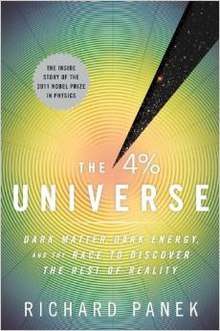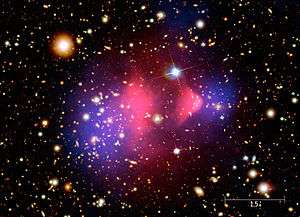The 4 Percent Universe
The 4 Percent Universe: Dark Matter, Dark Energy, and the Race to Discover the Rest of Reality is a nonfiction book by writer and professor Richard Panek and published by Houghton Mifflin Harcourt on January 10, 2011.
 Softcover edition | |
| Author | Richard Panek |
|---|---|
| Country | United States |
| Language | English |
| Subject | Astronomy, physics |
| Genre | Non-fiction |
| Publisher | Houghton Mifflin Harcourt |
Publication date | January 10, 2011 |
| Media type | Print, e-book |
| Pages | 320 pp. |
| ISBN | 0618982442 |
Content
The book's namesake comes from the scientific confusion over how ordinary matter makes up only four percent of the mass-energy in the universe, with the rest consisting of mysterious dark matter and dark energy that are both invisible and almost impossible to detect.[1] It is due to dark matter that galaxies are able to keep their shape, with the mass of dark matter creating enough gravitational force to hold the stars that make up a galaxy together. Dark energy, however, is a substance or force responsible for the accelerating expansion of the universe over time.[1]
The significant focus of The 4 Percent Universe is on the developments of astronomical science in the 20th century, including the formation of the expanding universe theory by Edwin Hubble in the 1930s. This model, when used in conjunction with Albert Einstein's general relativity helped in the creation of the Big Bang model and the later discovery of the cosmic background radiation in the 1960s. In following this history, Panek also discusses the flaws and missing pieces in the theories and the quest by two major scientific groups to discover the reason for the expansion of the universe not matching the models as expected. The book discusses the science behind the idea of dark matter being made up of weakly interacting massive particles and how scientists tried to determine the existence of dark energy from the 1990s and onward.[1][2] The two groups involved in this research were the Supernova Cosmology Project headed by Saul Perlmutter and the High-Z Supernova Search Team headed by Brian Schmidt, both of which were involved in pioneering the use of Type Ia supernovae as standard candles for determining the variation in the universe's rate of expansion over its history, which in turn allows prediction of its future expansion.[3]
Style
Salon's Laura Miller described Panek and his writing style as a "wondrously clear explicator of some thorny concepts".[4] Writing a review for Science News magazine, Ron Cowen commented that Panek "writes eloquently about the mind-bending search for meaning in a universe dominated by stuff no one can see", while he also "weaves together concepts from particle physics, relativity, quantum mechanics and cosmology with personal portraits of astronomers".[5]
Critical reception
Kirkus Reviews described the book as having "vivid sketches of scientists, lucid explanations of their work and revealing descriptions of the often stormy rivalry that led to this scientific revolution, usually a media cliché, but not in this case."[6] Choice magazine reviewer C. G. Wood rated the work as "highly recommended" and noted that while Panek "does not shortchange the science", the book mainly "concentrates on the personalities of those involved in the highly personal and sometimes bitter rivalry".[7] The convoluted nature and number of scientists, organizations, and events involved in the book's topic is pointed out by Carl Zimmer in writing for The Washington Post, who stated that "Panek's passion for the mysteries of dark matter and dark energy wins the day" and that the premise "succeeds because he recognizes that he's writing not just about red shifts and supernovae, but about people".[8] In a special for The Dallas Morning News, author Fred Bortz commended how Panek takes the complicated scientific nature of the book's topic and "weaves that science into a compelling narrative of a quest full of technological challenges, unexpected turns and expected human rivalries over high stakes, including perhaps a future Nobel Prize."[9]
Samantha Nelson for The A.V. Club rated the book a C-, lamenting how Panek is able to describe scientific material in an understandable manner, but that the science is "bogged down by Panek's focus on the teams researching cosmology", finally noting that the "people behind the scientific discoveries deserve credit, but the science should still be the star of the book."[10]
See also
References
- Falk, Dan (January 22, 2011). "In search of the cosmic unknowns". New Scientist. Reed Business Information. 209 (2796): 46. Bibcode:2011NewSc.209...46F. doi:10.1016/S0262-4079(11)60162-0.
- Woit, Peter (January 31, 2011). "What Happens In the Dark". Wall Street Journal. Retrieved December 10, 2014.
- Orzel, Chad (January 5, 2011). "The Four Percent Universe by Richard Panek". ScienceBlogs. Seed Media Group. Retrieved December 10, 2014.
- Miller, Laura (January 9, 2011). ""The 4 Percent Universe": Dark matter and dueling scientists". Salon. San Francisco: Salon Media Group. Retrieved July 16, 2014.
- Cowen, Ron (December 4, 2010). "Book Review: The 4 Percent Universe: Dark Matter, Dark Energy and the Race to Discover the Rest of Reality by Richard Panek". Science News. Society for Science and the Public: 32. Retrieved July 16, 2014.
- "The 4 Percent Universe: Kirkus Review". Kirkus Reviews. Herbert Simon. November 15, 2010. Retrieved June 25, 2014.
- Wood, C. G. (August 2011). "The 4 percent universe: dark matter, dark energy, and the race to discover the rest of reality". Choice: Current Reviews for Academic Libraries. Association of College and Research Libraries. 48 (12): 6877. doi:10.5860/CHOICE.48-6877. Retrieved June 26, 2014.
- Zimmer, Carl (January 28, 2011). "Richard Panek's study of the cosmos,"The 4 Percent Universe"". The Washington Post. Washington D.C.: Katharine Weymouth. Retrieved July 16, 2014.
- Bortz, Fred (January 9, 2011). "Book review: 'The 4 Percent Universe' by Richard Panek". The Dallas Morning News. Dallas, Texas: James M. Moroney III. Retrieved July 20, 2014.
- Nelson, Samantha (January 27, 2011). "Richard Panek: The 4% Universe". The A.V. Club. Retrieved December 10, 2014.
Further reading
- Lea, Richard (March 18, 2011). "The 4% Universe by Richard Panek – review". The Guardian. Retrieved December 10, 2014.
- "The 4% Universe: Dark Matter, Dark Energy, and the Race to Discover the Rest of Reaiity". Publishers Weekly. PWxyz LLC. 257 (48): 42. December 6, 2010. Retrieved December 10, 2014.
